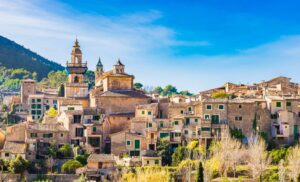UNESCO World Heritage Sites in Spain and Portugal that deserve a spot on your list.
Granada – Alhambra
The Alhambra, ‘the red palace’, is the most famous building in the southern Spanish city of Granada. Quite rightly a UNESCO World Heritage Site as far as we are concerned. The Moorish building – until 1492 Granada belonged to Al-Andalus, as the Moors called the part of the Iberian Peninsula they conquered – was built as a fortress on the edge of the city. Later it was converted into a palace.
Most striking is the beautiful Arabic architecture, with attention to the smallest details. The number of visitors is limited to 6,600 per day. The entrance to the central Nasrid Palace is divided into time slots. Once inside you can take all your time.
Therefore, book your ticket for the earliest possible access at 8:30 am. It is still relatively quiet at that hour. First visit the Alhambra itself and then walk through the palace gardens, for example around the Moorish summer palace Generalife.
Cordoba – Mezquita
The original name read “Great Mosque of Córdoba”, referring to a 7th century Catholic church that was converted into a mosque in the 8th century, and restored into a Roman Catholic cathedral by Ferdinand III in the 13th century. During the height of the region’s Moorish rule, Córdoba housed more than three hundred mosques and an architectural scene rivaling that of Constantinople, Damascus, and Baghdad; the entire city is an open-air museum.
Barcelona – Gaudí
Antoni Gaudí’s unique architectural designs are part of the modernist style. The original registration included Park Güell, Palau Güell and Casa Milà; in 2005 the registration was expanded to include Casa Vicens, the crypt and nativity facade of the Sagrada Família, Casa Batlló and Cripta Colònia Güell.
The Alcázar was built during the time of the Almohads who ruled in the south of Spain until the Reconquista. The cathedral dates back to the 15th century and houses the tombs of Ferdinand III and Christopher Columbus. The Archivo (Archive) houses documents related to the Spanish colonization of America.
Doñana National Park
The park consists of the delta area where the Guadalquivir River flows into the Atlantic Ocean. It has a wide variety of biotopes, such as lagoons, swamps, dunes and maquis. It has one of the largest heron colonies in the Mediterranean and is home to more than 500,000 birds during the winter period.
Valencia – Elche
The orchard with date palms and irrigation system was built by the Moors in the 10th century. This palm orchard (palmeral) is a rare example of Arab agricultural practices in Europe.
Antequera – Dolmen
This heritage consists of a set of three cultural monuments (Dolmen of Menga, Dolmen of Viera and Tholos de El Romeral) and two natural monuments (the mountain formations of Peña de los Enamorados and El Torcal).
Lisbon – Monastery of the Jeronymites and Tower of Belém
The Monastery of the Hieronymites stands at the entrance to the port of Lisbon. The construction of this monastery started in 1502. It is an excellent example of Portuguese art.
The nearby Tower of Belém was built to commemorate Vasco da Gama’s voyage of discovery. It is a reminder of the great maritime discoveries that laid the foundations of the modern world. The Tower of Belém is located in the city district of the same name. The tower was built between 1515 and 1521 and served as a lookout post to keep enemy ships out of the harbor at an early stage.
Portugal – Royal Building of Mafra
Located 30 km northwest of Lisbon, the property was designed by King João V in 1711 as a tangible representation of his conception of the monarchy and the state. This imposing quadrangular building houses the palaces of the king and queen, the royal chapel in the form of a Roman Baroque basilica, a Franciscan monastery and a library with 36,000 books. The complex is completed by the Cerco Garden, with its geometric layout, and the Royal Hunting Park (Tapada).
The Royal Mafra Building is one of King João V’s most notable works, illustrating the power and reach of the Portuguese Empire. João V adopted architectural and artistic models from the Roman and Italian Baroque and commissioned works of art that make Mafra an exceptional example of Italian Baroque.
Portugal – Alto Douro wine region (at UNESCO they also love good wine)
Traditional landowners in the Alto Douro region have been producing wine for approximately 2,000 years. Since the 18th century, port (wine) – the main product of the region – has been world famous for its quality.
The long tradition of viticulture has produced a cultural landscape of extraordinary beauty, which reflects its technological, social and economic development. The topsoil must be held in place on the steep slopes by dams.
The most characteristic feature of the landscape of Alto Douro are the vineyard terraces. They have been constructed over the centuries using different techniques, row upon row. The current terraces date from the 19th century.



